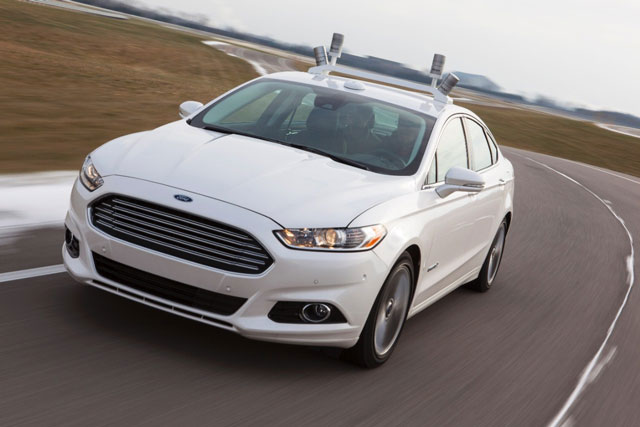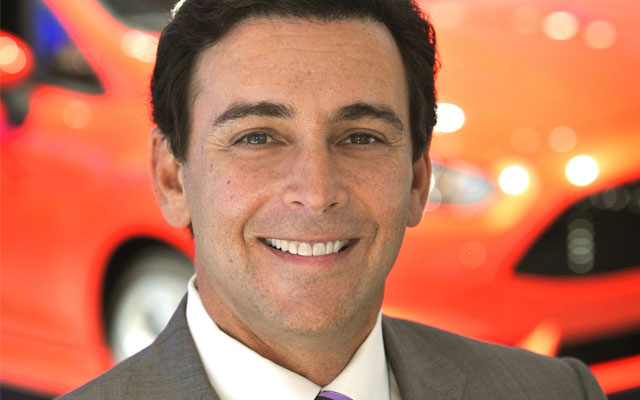
Ford Motor Co, which put the world on wheels a century ago, is now taking the driver out of the driver’s seat.
The company said it plans to have a fully autonomous vehicle — no steering wheel and no accelerator or brake pedals — available by 2021 for ride-hailing services.
“We see the autonomous car changing the way the world moves once again,” CEO Mark Fields said at Ford’s research lab in Palo Alto, California. “They address a whole host of safety, social and environmental issues.”
Like Google, Ford will skip the interim steps of driver-assisted technology as a way to evolve toward full autonomy. Its plan to deploy self-driving cars in ride-hailing and ride-sharing fleets is similar to what General Motors aims to do with Lyft. Ford’s 2021 scheduled start matches BMW’s ambitious timeframe.
“We believe in our plan that taking the driver out of the loop is really important,” Fields said in an interview with Bloomberg Television. The automaker couldn’t find a sensible way through the “no man’s land” — determining exactly when a robotic car should to try to re-engage a human driver in an emergency.
The second biggest US car maker didn’t say how many autonomous cars it plans to produce by 2021. Earlier on Tuesday, Ford said it’s doubling the number of people at the Silicon Valley lab to 260 while expanding to two more buildings. It also invested $75m in the leading maker of an advanced radar system to accelerate its development of self-driving cars.
There’s some catching up to do: Google’s self-driving car project has already amassed almost 3m kilometres of public road testing. Ford said it’s investing in or collaborating with four start-ups on autonomous vehicles, bringing its roster of such partnerships to 40.
Ford’s plan lacks specifics of how it will make this great leap to full automation, said Michelle Krebs, senior analyst for researcher Autotrader.
“I’m not seeing all the pieces of the puzzle in place because they don’t have a relationship with a ride-hailing service like Uber or Lyft,” Krebs said. “It’s a first step and at least Wall Street will see that they’re working on this.”

Lidar investment
Ford and China’s top search engine company, Baidu, are each investing $75m in Velodyne Lidar, the car maker said in a statement. Lidar bounces light off objects to assess shape and location, giving self-driving cars a 360-degree view of their environment with the help of cameras and traditional radar.
Morgan Hill, California-based Velodyne said the money will help it improve design and expand production, making the sensors more affordable for mass adoption.
Ford wants “to do as much as they can internally, but also acknowledge that it’s best to partner with those who have the leading technology”, Jeff Schuster, an analyst at research firm LMC Automotive.
Ford also said it acquired SAIPS, an Israel-based computer vision and machine learning company, to boost its capabilities in artificial intelligence. In addition, the company struck an exclusive licensing agreement with New York-based Nirenberg Neuroscience, founded by neuroscientist Sheila Nirenberg. Ford said she has developed a machine vision platform that it hopes can bring “human-like intelligence” to autonomous cars. Ford didn’t disclose financial details of either deal.
Ford reiterated last month’s announcement that it was among five investors providing $6,6m in seed funding for Civil Maps, a California start-up that creates three-dimensional maps for driverless cars.
GM acquisitions
General Motors has spent almost $600m — and will spend more — acquiring self-driving software maker Cruise Automation and invested $500m for a 9% stake in Lyft. Fiat Chrysler Automobiles has teamed up with Google to develop 100 self-driving minivans. Ford conducted unsuccessful negotiations with Google prior to the Chrysler deal.
Since GM announced its acquisition of Cruise Automation in March, the staff at the company has grown to 100 from 40, said Kevin Kelly, a GM spokesman. GM is testing Cruise’s self-driving software on Chevy Bolt electric cars in Scottsdale, Arizona. GM also has a research lab in Palo Alto that employs about 12 people, Kelly said.
“Our goal is to use our autonomous technology in an on-demand ride-sharing network,” Kelly said. “Cruise paired perfectly with Lyft.”
Velodyne said it “expects an exponential increase in lidar sensor deployments” and that it will continue to work with top automotive and ride-sharing companies worldwide.
“We want the cost to be low enough to be used for all cars,” Marta Hall, Velodyne’s president of business development, said in the statement. — (c) 2016 Bloomberg LP

